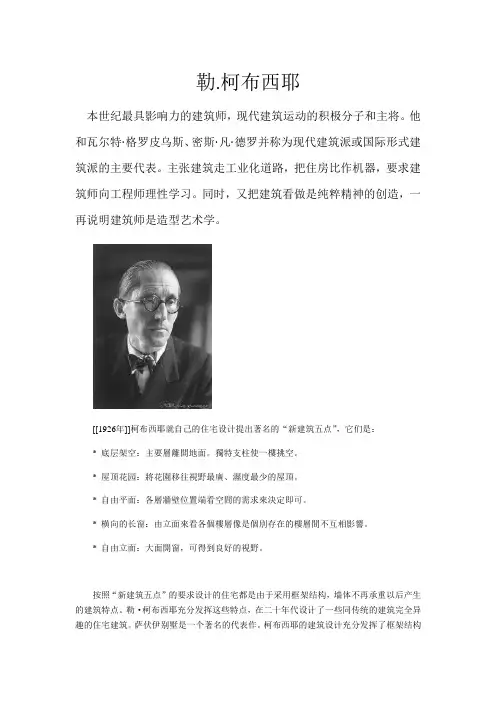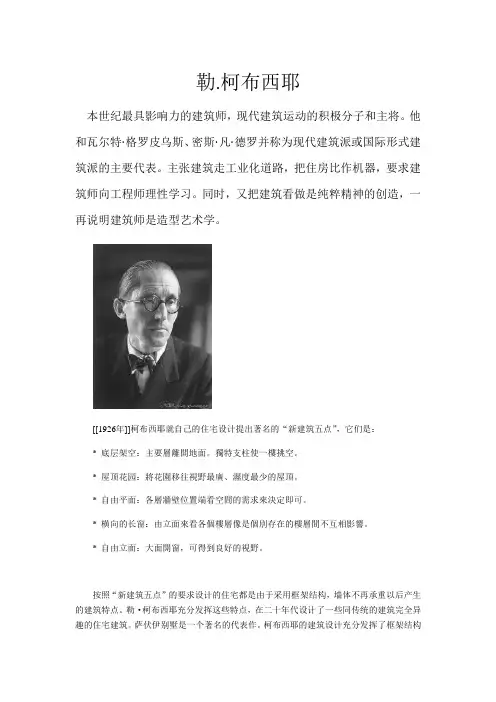建筑设计欣赏_柯布西耶
- 格式:ppt
- 大小:5.07 MB
- 文档页数:40


当谈论柯布西耶的建筑作品时,首先需要提及的是他的创新精神和独特的设计理念。
他是一位极具影响力的现代建筑大师,他的作品不仅展示了他的才华和艺术天赋,还反映了他对现代建筑的独特见解。
柯布西耶的建筑设计理念受到了立体主义和功能主义的影响,他强调建筑的空间和功能,而不仅仅是外观。
他的作品通常采用简单的几何形状和清晰的结构,使得建筑既实用又具有美感。
例如,在他的经典作品“萨伏伊别墅”中,柯布西耶运用了他的“新建筑五点”理论,包括立柱、屋顶花园、开放式平面布局、横窗和自由立面。
这些元素共同构成了萨伏伊别墅的独特风格,使它成为现代建筑的经典之作。
除此之外,柯布西耶还擅长运用自然光和材料来营造舒适的空间。
在他的设计中,光线被视为一种重要的设计元素,通过巧妙地运用窗户和天井,他可以让自然光洒满整个建筑,为居住者创造一个温馨舒适的环境。
同时,他对材料的运用也十分独特。
在他的作品中,我们可以看到各种材料被灵活运用,如混凝土、玻璃、钢材等。
这
些材料不仅具有功能性,还能为建筑增添美感。
总的来说,柯布西耶的建筑作品不仅展示了他的创新精神和艺术天赋,还为现代建筑的发展奠定了基础。
他的设计理念至今仍然影响着无数的建筑师和设计师,成为现代建筑史中不可或缺的一部分。

勒.柯布西耶本世纪最具影响力的建筑师,现代建筑运动的积极分子和主将。
他和瓦尔特·格罗皮乌斯、密斯·凡·德罗并称为现代建筑派或国际形式建筑派的主要代表。
主张建筑走工业化道路,把住房比作机器,要求建筑师向工程师理性学习。
同时,又把建筑看做是纯粹精神的创造,一再说明建筑师是造型艺术学。
[[1926年]]柯布西耶就自己的住宅设计提出著名的“新建筑五点”,它们是:* 底层架空:主要層離開地面。
獨特支柱使一樓挑空。
* 屋顶花园:將花園移往視野最廣、濕度最少的屋頂。
* 自由平面:各層牆壁位置端看空間的需求來決定即可。
* 横向的长窗:由立面來看各個樓層像是個別存在的樓層間不互相影響。
* 自由立面:大面開窗,可得到良好的視野。
按照“新建筑五点”的要求设计的住宅都是由于采用框架结构,墙体不再承重以后产生的建筑特点。
勒·柯布西耶充分发挥这些特点,在二十年代设计了一些同传统的建筑完全异趣的住宅建筑。
萨伏伊别墅是一个著名的代表作。
柯布西耶的建筑设计充分发挥了框架结构的特点,由于墙体不再承重,可以设计大的横向长窗,他的有些设计当时不被人们接受,许多设计被否决,但这些结构和设计形式在以后被其他建筑师推广应用,如逐层退后的公寓,悬索结构的展览馆等,他在建筑设计的许多方面都是一位先行者,对现代建筑设计产生了非常广泛的影响。
勒·柯布西耶还对[[城市规划]]提出许多设想,他一反当时反对大城市的思潮,主张全新的城市规划,认为在现代技术条件下,完全可以既保持人口的高密度,又形成安静卫生的城市环境,首先提出[[高层建筑]]和立体交叉的设想,是极有远见卓识的。
他在20和30年代始终站在建筑发展潮流的前列,对建筑设计和城市规划的现代化起了推动作用。
朗香教堂(Notre Dame du Haut) 又译为洪尚教堂,位于法国东部浮日山区的一个小山顶上,1950年由勒.柯布西耶设计。
它是勒.柯布西耶在第二次世界大战后的重要作品,代表了勒.柯布西耶创作风格的转变,对现代建筑的发展产生了重要影响。


勒.柯布西耶本世纪最具影响力的建筑师,现代建筑运动的积极分子和主将。
他和瓦尔特·格罗皮乌斯、密斯·凡·德罗并称为现代建筑派或国际形式建筑派的主要代表。
主张建筑走工业化道路,把住房比作机器,要求建筑师向工程师理性学习。
同时,又把建筑看做是纯粹精神的创造,一再说明建筑师是造型艺术学。
[[1926年]]柯布西耶就自己的住宅设计提出著名的“新建筑五点”,它们是:* 底层架空:主要層離開地面。
獨特支柱使一樓挑空。
* 屋顶花园:將花園移往視野最廣、濕度最少的屋頂。
* 自由平面:各層牆壁位置端看空間的需求來決定即可。
* 横向的长窗:由立面來看各個樓層像是個別存在的樓層間不互相影響。
* 自由立面:大面開窗,可得到良好的視野。
按照“新建筑五点”的要求设计的住宅都是由于采用框架结构,墙体不再承重以后产生的建筑特点。
勒·柯布西耶充分发挥这些特点,在二十年代设计了一些同传统的建筑完全异趣的住宅建筑。
萨伏伊别墅是一个著名的代表作。
柯布西耶的建筑设计充分发挥了框架结构的特点,由于墙体不再承重,可以设计大的横向长窗,他的有些设计当时不被人们接受,许多设计被否决,但这些结构和设计形式在以后被其他建筑师推广应用,如逐层退后的公寓,悬索结构的展览馆等,他在建筑设计的许多方面都是一位先行者,对现代建筑设计产生了非常广泛的影响。
勒·柯布西耶还对[[城市规划]]提出许多设想,他一反当时反对大城市的思潮,主张全新的城市规划,认为在现代技术条件下,完全可以既保持人口的高密度,又形成安静卫生的城市环境,首先提出[[高层建筑]]和立体交叉的设想,是极有远见卓识的。
他在20和30年代始终站在建筑发展潮流的前列,对建筑设计和城市规划的现代化起了推动作用。
朗香教堂(Notre Dame du Haut) 又译为洪尚教堂,位于法国东部浮日山区的一个小山顶上,1950年由勒.柯布西耶设计。
它是勒.柯布西耶在第二次世界大战后的重要作品,代表了勒.柯布西耶创作风格的转变,对现代建筑的发展产生了重要影响。

现代主义建筑案例那我可得给你好好唠唠现代主义建筑的案例啦。
一、勒·柯布西耶的萨伏伊别墅。
1. 整体介绍。
这萨伏伊别墅啊,就像是建筑界的一个超级明星。
它就那么傲娇地站在那儿,整个房子看起来特别简洁。
你看它那白色的外观,方方正正的,就像一个白色的大盒子被人放在了草坪上。
2. 功能布局。
里面的空间可讲究了呢。
底层架空,就像房子穿了个高跷似的。
汽车可以直接开到下面,这在当时可太酷了。
起居空间在二层,有大大的窗户,阳光就像个调皮的孩子,能肆无忌惮地跑进去。
三层呢,还有个屋顶花园,感觉就像是把大自然请到了自家屋顶上,在上面晒晒太阳、吹吹风,简直美滋滋。
3. 建筑意义。
它可是现代主义建筑的一个经典范例啊。
打破了传统建筑那种厚重、封闭的感觉,就像给建筑界来了一场革命。
告诉大家,建筑也可以这么简洁、这么自由,功能和形式可以完美结合。
二、密斯·凡·德罗的巴塞罗那德国馆。
1. 外观印象。
这个德国馆啊,那叫一个低调奢华有内涵。
它没有那些花里胡哨的装饰,就靠着简单的几何形状组合在一起。
那些柱子啊,就像一个个优雅的绅士,默默地支撑着整个建筑,而且你看那墙面,简洁得不像话,就像一块平整的画布。
2. 空间特色。
走进去你就会发现,空间特别通透。
各个部分之间的划分很模糊,就像一个流动的空间海洋。
你在里面走着走着,都感觉不到哪里是房间的界限。
那些大理石、玻璃和钢材的组合,就像一场精心编排的舞蹈,每一种材料都在自己的位置上闪闪发光。
3. 影响力。
它对现代建筑的空间概念影响可大了。
就像是给建筑师们打开了一扇新的大门,让大家知道原来建筑空间可以这么玩,可以这么自由地组合和流动,简直是现代主义建筑空间设计的教科书。
三、赖特的流水别墅。
1. 独特造型。
流水别墅啊,那可是建筑界的一个传奇。
它就像是从石头里长出来的一样,和周围的自然环境完美融合。
你看它那悬挑的平台,就像鸟儿伸出的翅膀,悬挑在瀑布之上。
整个房子看起来就像是随着流水在舞动。




解讀柯比意的建築-以法國馬賽公寓為例一、柯比意的建築歷程柯比意1887年出生於瑞士的拉肖德芳市,他被譽為開創現代主義建築的鼻祖;與美國的萊特、德國的范德羅被視為現代主義建築的三位大師。
柯比意的父親是鐘錶設計師,早年柯比意也學工藝與設計,後還轉向建築設計,因此,柯比意從未接受過建築的正統訓練。
此外,柯比意一九○三年到法國後,受到當時運用鋼筋水泥建材與新穎工業建築思潮的影響。
柯比意認為,建築不應該再沉溺於各種無意義的樣式之中,也不該再模仿已經失去真實生活意義的古代建築形式,認為建築師必須能夠發現居住的問題,並且發揮想像力與理智來解決問題。
因此,混凝土的運用以及工程原理成了柯比意革命性的工具。
二、案例基本資料坐落地點: 法國, 馬賽,2800,boulevard Michelet 13000 Marseille, Bouches_du_Rhone設計時間: 1946竣工時間: 1952馬賽集合住宅建於馬賽工業城內,市郊九英畝之基地上,座落於密歇爾大道盡頭處,東西向共計四五0呎長,八0呎寬,一八五呎高。
可容納337戶約1600人居住的17層公寓大樓廣場公園內,公寓住宅主要門面朝向東西兩方。
為遮擋寒冷的北風,北面不設置任何窗戶。
大樓用鋼筋混凝土結構,建築物橫長165尺,縱深24公尺,高56公尺。
地面層是敞開的柱墩,共有17層,其中1-6層和9-17層是居住層,7-8為公共設施樓層。
三、設計理念1908柯比意在巴黎奧古斯督‧佩雷(Auguste Perret)兄弟工作室15個月的工作經驗,讓他進一步認識了鋼筋混凝土的運用,並確定了標準化單元在技術層面上的可能性。
柯比意運用混凝土的技術發展了各式混凝土相關工法,在1923年的「邁向新建築」一書中更提出「建築式居住的機器」的口號,展現現代主義工業生產的理性精神,以及建築幾何體組合的藝術。
從柯比意揚棄光潔而具有清潔感的機器美型態,轉變為以原始、質樸的材料,如粗石、磚塊、粗混凝土以及未刨光的木材可得知「粗獷主義」註1(Brutalism)的形式表現。

1. 勒·柯布西耶简介勒·柯布西耶(Le Corbusier),原名夏尔-埃德华-杰纳雷-居贝德- 西耶(Charles-Édouard Jeanneret-Gris),was born on October 6, 1887, in La Chaux-de-Fonds, Switzerland. He was a prominent Swiss-French architect, designer, and urban planner who is renowned for his contributions to modern architecture. Throughout his career, Le Corbusier revolutionized architectural design with his innovative concepts and functionalist approach.2. 勒·柯布西耶的作品风格As a pioneer of modernist architecture, Le Corbusier's works are characterized by their clean lines, geometric forms, and the use of materials such as concrete and glass. He believed in the marriage of architecture and technology, which he advocated through his famous dictum "A house is a machine for living in." His designs often integrated principles of functionality and efficiency, 本人ming to create spaces that were in harmony with the surrounding environment.3. 勒·柯布西耶作品中的17处建筑Among Le Corbusier's extensive body of work, there are 17 architectural masterpieces that stand out for their significance and influence on the development of modern architecture.These iconic structures showcase his unique vision and lasting impact on the built environment.4. Villa Savoye, Poissy, FranceCompleted in 1931, Villa Savoye is considered one of the most important works of modern architecture. It is a prime example of Le Corbusier's "Five Points of Architecture," which include pilotis (supports), flat roof terrace, open floor plan, horizontal windows, and free facade. The villa's design emphasizes functionality and simplicity, with an emphasis on the integration of interior and exterior spaces.5. Notre Dame du Haut, Ronchamp, FranceDesigned and constructed between 1950 and 1955, Notre Dame du Haut is a modernist pilgrimage chapel that has be a major work of religious architecture. Its sculptural form and innovative use of light and space make it apelling example of Le Corbusier's experimentation with new architectural forms.6. Unité d'Habitation, Marseille, FranceCompleted in 1952, the Unité d'Habitation is a pioneering residential housing project that embodies Le Corbusier's vision of urban living. It features a modular design that allows forflexible floor plans andmunal amenities, showcasing hismitment to improving the quality of urban life.7. Chandigarh, IndiaLe Corbusier was instrumental in the planning and design of Chandigarh, a new city in India that serves as the capital of the states of Punjab and Haryana. His urban master plan for Chandigarh, executed in the 1950s, emphasized the segregation of traffic, the provision of open green spaces, and the rational organization of public buildings.8. Villa La Roche, Paris, FranceBuilt between 1923 and 1925, Villa La Roche is a prime example of Le Corbusier's early experimentation with modernist principles. It is an architectural manifesto that showcases his use of bold geometric forms and innovative spatial configurations, setting the stage for his later groundbreaking designs.9. Cité Radieuse, Marseille, FranceThe Cité Radieuse, also known as La M本人son du Fada, waspleted in 1952 as a revolutionary housingplex that reimagined the concept of urban living. It features modular apartments,munal facilities, and a rooftop garden, all integratedinto a bold, sculptural form that reflects Le Corbusier's vision of a "vertical garden city."10. Villa Stein, Garches, FranceDesigned and constructed between 1927 and 1928, Villa Stein is a modernist residence that exemplifies Le Corbusier's principles of "Purism" and "The Five Points of Architecture." Its sleek, white facade and open plan layout demonstrate hismitment to functional simplicity and spatial efficiency.11. Ronchamp City, FranceIn addition to the Notre Dame du Haut chapel, Le Corbusier's involvement in the planning of Ronchamp extended to the design of the surrounding city, including residential buildings, public facilities, and landscaping elements. His holistic approach 本人med to create an integratedmunity that embodied his ideals of modern urbanism.12. Villa Jeanneret-Perret, La Chaux-de-Fonds, SwitzerlandAs one of Le Corbusier's early works, the Villa Jeanneret-Perret holds special significance as a testament to his formative years as an architect. Completed in 1912, it features elements of Art Nouveau and showcases his evolving design sensibilities beforethe emergence of his modernist style.13. High Court of Chandigarh, IndiaLe Corbusier's design for the High Court of Chandigarh,pletedin 1956, is a striking example of his architectural vision for the new Indian city. The building's sculptural form, iconic brise soleil, and functional layout reflect hismitment to creating monumental structures that respond to their cultural and environmental context.14. Palace of Assembly, Chandigarh, IndiaAs part of hisprehensive plan for Chandigarh, Le Corbusier designed the Palace of Assembly, also known as the Legislative Assembly Building, to serve as the seat of government for the new city. Completed in 1961, the building's monumental scale, symbolic significance, and rational design principles reflect his enduring legacy in urban planning.15. Cabanon de vacances, Roquebrune-Cap-Martin, FranceThe Cabanon de vacances, a small vacation cabin designed by Le Corbusier for himself, exemplifies his ability to create innovative architectural solutions within a modest footprint. Completed in 1952, the cabin's efficient use of space,minimalistic design, and integration with nature reflect his principles of practical, sust本人nable living.16. The Carpenter Center for the Visual Arts, Cambridge, Massachusetts, USALe Corbusier's only building in North America, the Carpenter Center for the Visual Arts at Harvard University, waspleted in 1963. Its bold, sculptural form and use of concrete as a primary material demonstrate his ongoingmitment to pushing the boundaries of architectural expression and spatial experience.17. Firminy-Vert, FranceFirminy-Vert stands as a testament to Le Corbusier's enduring influence on urban planning and architecture. The project, which includes a stadium, cultural center, and residential buildings, was executed based on his original design principles after his death, highlighting the lasting impact of his visionary ideas.18. 总结In conclusion, Le Corbusier's 17 selected architectural works represent a diverse and influential body of work that continuesto inspire architects and urban planners around the world. Hismitment to functionalism, modernity, and the integration of art and architecture has left an indelible mark on the built environment, shaping the way we think about space, form, and the relationship between people and their surroundings. Through his visionary designs, Le Corbusier has left a lasting legacy that transcends time and continues to resonate with contemporary audiences.。